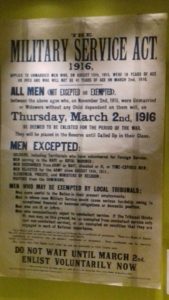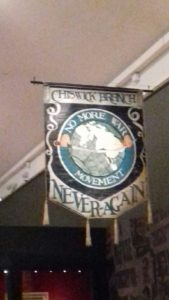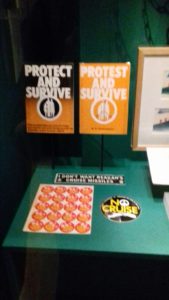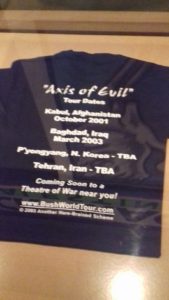 …is the sub-title of a new exhibition at the Imperial War Museum, Lambeth Road (nearest tube Lambeth North station, Bakerloo line). We visited last week.
…is the sub-title of a new exhibition at the Imperial War Museum, Lambeth Road (nearest tube Lambeth North station, Bakerloo line). We visited last week.
It is billed as an exploration of peace movements from the First World War to the present day and gives the IWM the opportunity to display its copious collection of, mainly British, anti-war documents and artefacts. There is much to see, from posters, letters and  banners, and to hear, individual testaments to experience. Some of the, previously anonymous, individuals whose letters, possessions and photographs are presented here have poignant tales of a different kind of heroism to the mainstream.
banners, and to hear, individual testaments to experience. Some of the, previously anonymous, individuals whose letters, possessions and photographs are presented here have poignant tales of a different kind of heroism to the mainstream.
There are the well-known, Siegfried Sassoon, the WWI poet, for example, or, later, the Quaker actor Paul Eddington, forever famous to British TV viewers as Jerry in The Good Life and the Prime Minister in Yes, Prime Minister, as well as the unknown.
Conscientious objectors (COs) in Britain the First World War were, if shipped to the front where they refused to serve, threatened with the death penalty  and often returned to the UK to be incarcerated in Dartmoor or The Scrubs. Ironically, during the Second World War, when there was much more of a moral imperative to fight, against Nazism, COs were treated much more sympathetically.
and often returned to the UK to be incarcerated in Dartmoor or The Scrubs. Ironically, during the Second World War, when there was much more of a moral imperative to fight, against Nazism, COs were treated much more sympathetically.
This is where the exhibition is strong. It’s good history, even if, as for this visitor, it got rather difficult to read the small script inside the glass vitrines after a while. There is a lot of telling detail.
Another strength is the documents supporting the anti-nuclear movement, after Nagasaki and Hiroshima, with the formation of the Campaign for  Nuclear Disarmament (CND) and the Aldermaston and Portondown protests. The Committee of 100, organising direct, non-violent civil disobedience, is well served with photos and documents. But as we enter the 1960s, that great decade of protest, the exhibition rather glosses over Vietnam (the Grosvenor Square protests) and moves on to Greenham Common and the 1980s.
Nuclear Disarmament (CND) and the Aldermaston and Portondown protests. The Committee of 100, organising direct, non-violent civil disobedience, is well served with photos and documents. But as we enter the 1960s, that great decade of protest, the exhibition rather glosses over Vietnam (the Grosvenor Square protests) and moves on to Greenham Common and the 1980s.
Then the exhibition moves on to the War Against Terror, after the attack upon the Twin Towers, the invasion of Afghanistan and then Iraq. There are a lot of photos of the march against the Iraq war and video testimony. All this I found somewhat less satisfactory, maybe because I can remember it all.
My biggest complaint about this exhibition is that there is little attempt,  when covering whatever era, to really place the peace protests in the wider context. There are some German peace posters from the early twentieth century and some U.S. ones from the twentieth and twenty-first, but these don’t figure highly.
when covering whatever era, to really place the peace protests in the wider context. There are some German peace posters from the early twentieth century and some U.S. ones from the twentieth and twenty-first, but these don’t figure highly.
I remember an exhibition at the V & A of the artefacts of protest, which managed to do just that by having an interactive map showing the incidence of protests across the globe by decade. The protests it focused on weren’t necessarily anti-war ( though some such featured ) but, while there was less of a narrative chronology, there was an attempt to interrogate the protests rather more, at home and abroad, and follow their progress. There was also rather more variety in how the protests were presented in the exhibition.
The IWM could argue, I suppose, that this is specifically a British exhibition, but I think they miss a trick. Why no Boer War – a war which divided public opinion just as much as the Iraq War? Why no global context? I have seen some wonderful exhibitions at the IWM like that on the art of the First World War. Real to Reel on the cinema of war, was good, if largely anglophone. But Fighting for Peace, like Fashion on the Ration, seems to be dictated by what the IWM has in its collections rather than by a genuine intellectual curiosity to investigate its subject matter. If that is there, it wasn’t really evident to this visitor.
This exhibition is not uninteresting, but is also not entirely satisfying – it didn’t tell me much that I didn’t know already and prompted lots of questions.
People Power; Fighting for Peace would be an educational experience for youngsters and is a bit of a trip down memory lane for those of a certain, older, generation, but it isn’t perhaps the most challenging of visits. It runs until mid-August and costs £10 to enter ( £7 concessions ).
If you enjoyed reading this article you might also enjoy Visit to Hertford House Somerset House Undiscovered Visit to the Leighton House Museum


 RSS – Posts
RSS – Posts